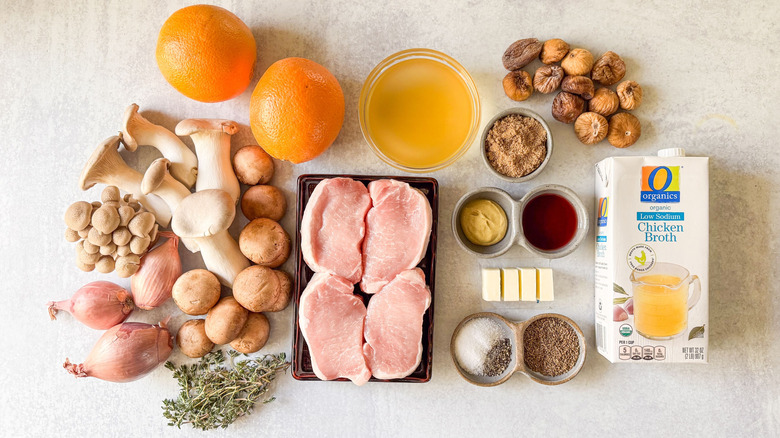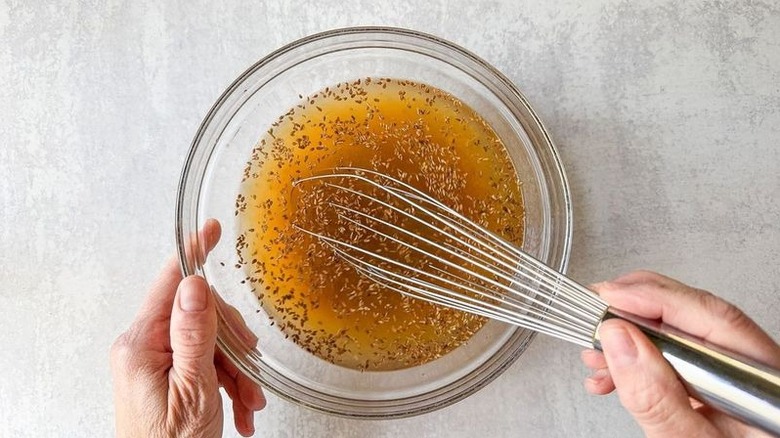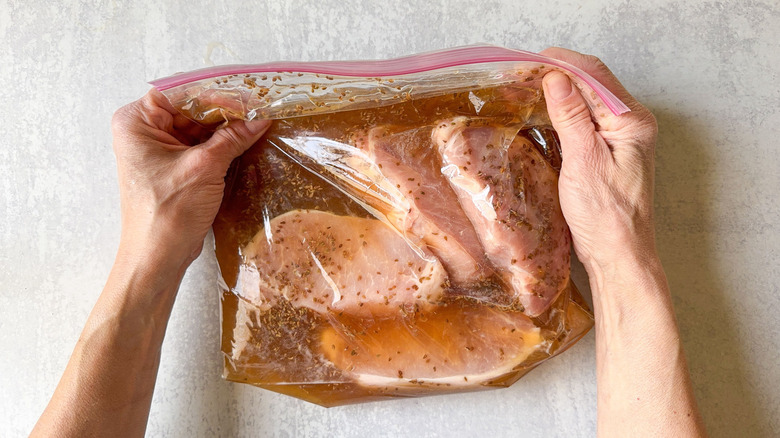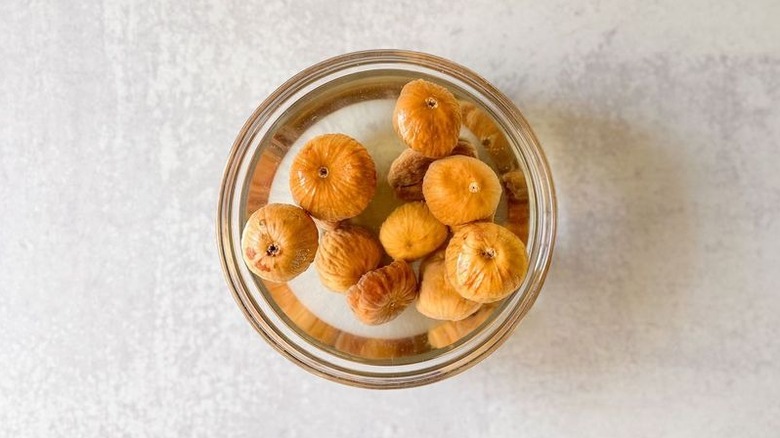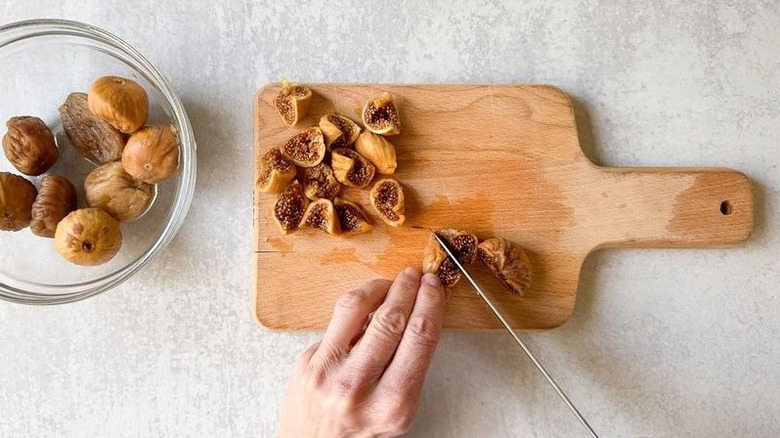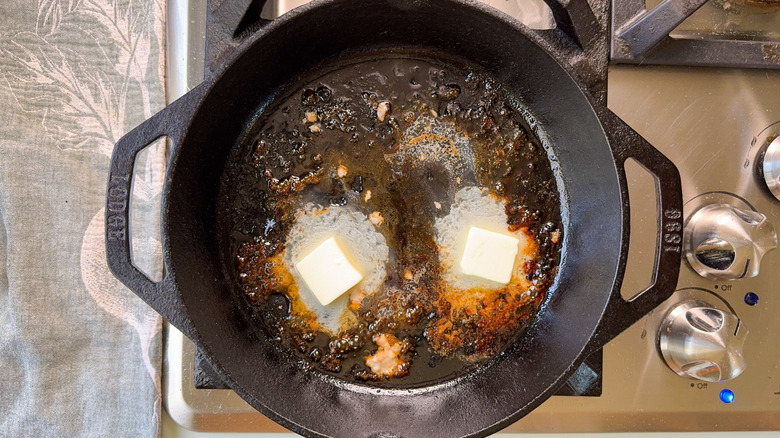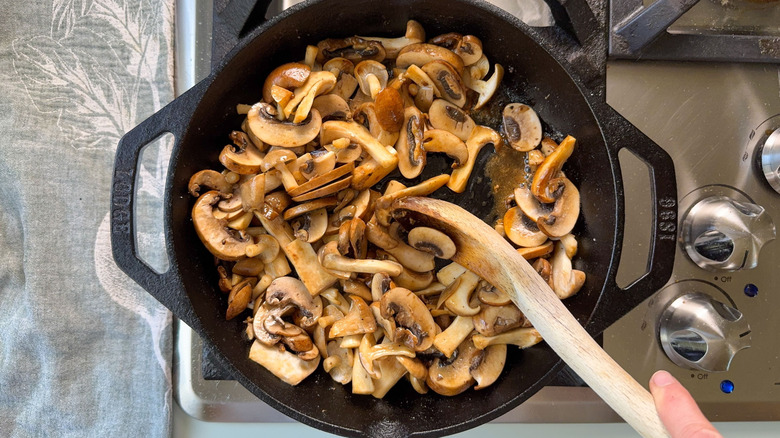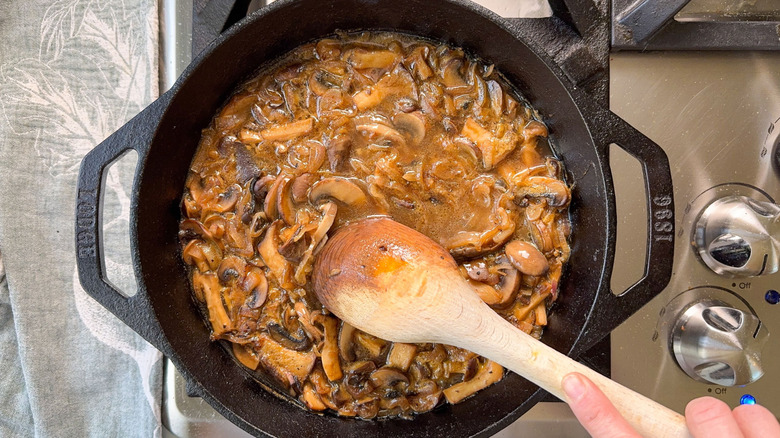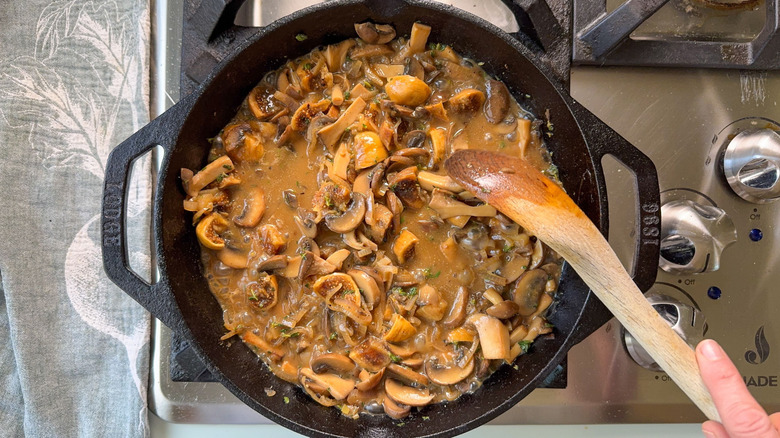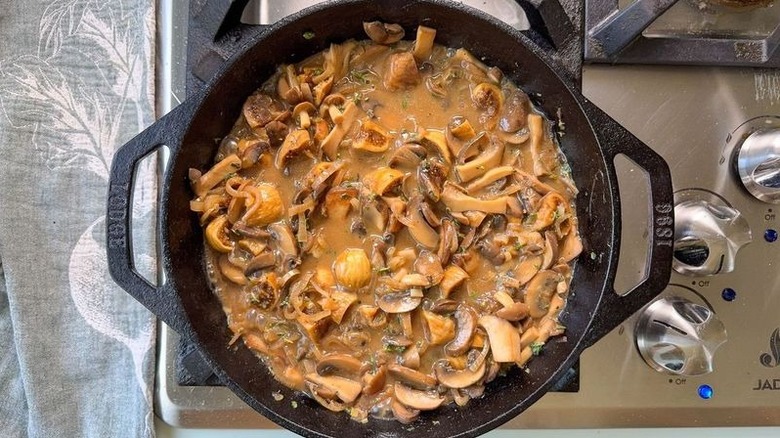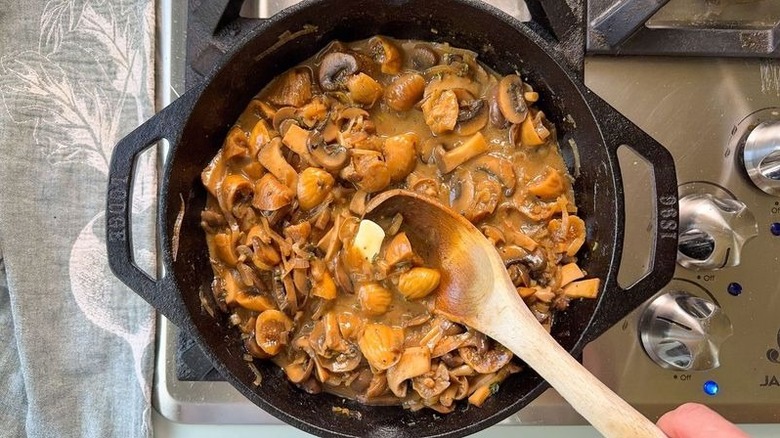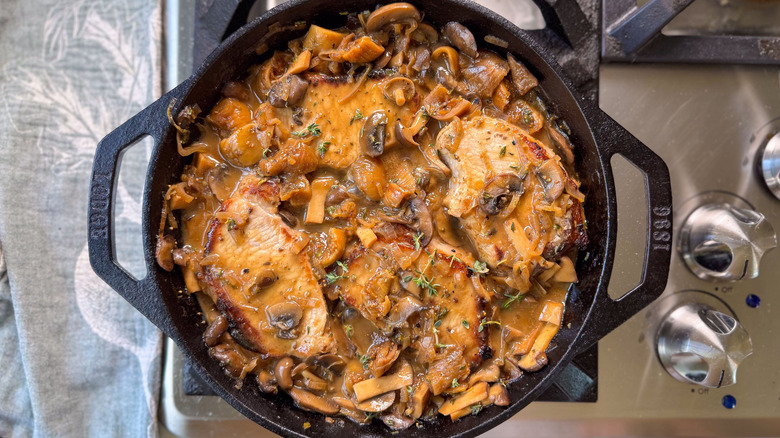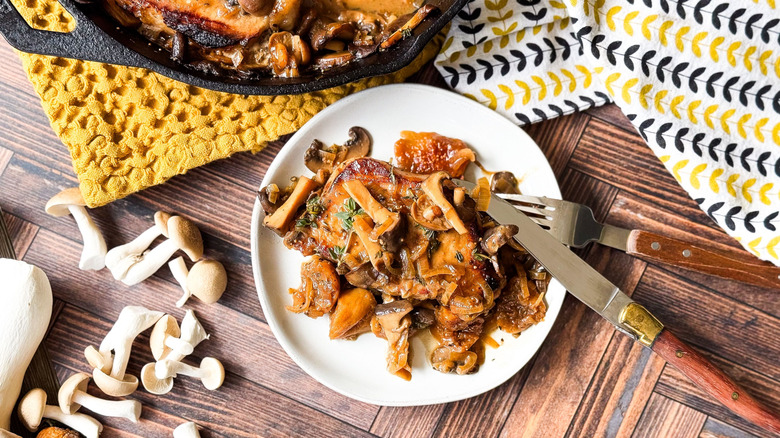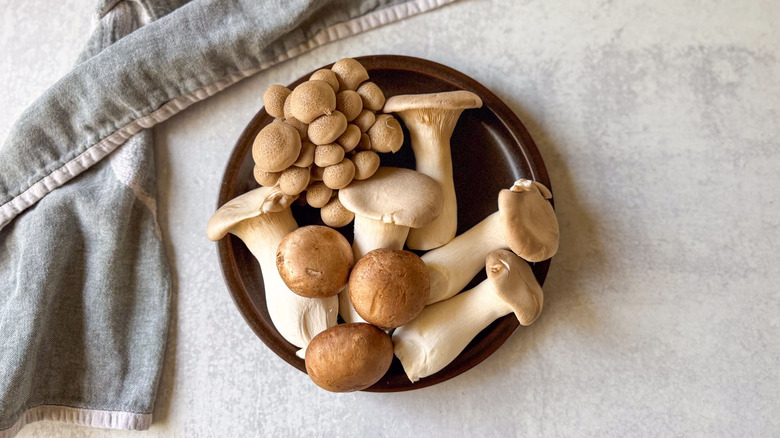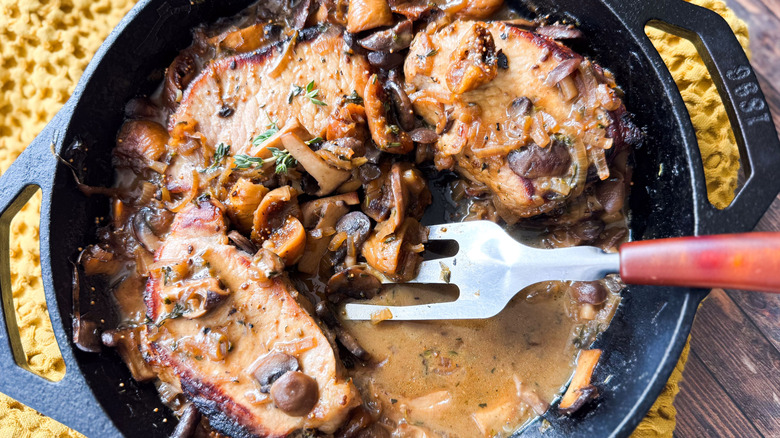Aromatic Smothered Pork Chops Recipe
Pork chops are culinary chameleons. You can fry them, bake them, or grill them with endless flavors and textures. The key to enjoying a succulent and flavorful pork chop is ensuring that it's packed with flavor and does not dry out during the cooking process. One way to guarantee both of these outcomes is to blanket the chops with a rich and umami-packed sauce. This recipe for aromatic smothered pork chops — courtesy of recipe developer Julie Kinnaird – features brined and pan-seared boneless pork chops with a braise of mixed mushrooms, shallots, and plenty of fresh thyme. Dried figs add sweetness, while a touch of mustard and red wine vinegar gives a piquant accent. Everything cooks in one pan for ease of preparation and keeping all of the flavors infused together.
The trick to the juiciest chops is the brining process. Apple cider vinegar, fresh orange juice, brown sugar, kosher salt, and fragrant aniseed infuse the pork with flavor while helping to tenderize the meat and boost its moisture. Kinnaird says that she loves to brine pork chops because they're a relatively lean cut and act like sponges to absorb flavors. Carefully drying the chops before searing helps to create a nice caramelization on the meat that is one of the most beloved aspects of a great pork chop.
Gather the aromatic smothered pork chops ingredients
The star ingredient in this recipe is the pork. Choose boneless, thick-cut pork loin chops. Not to be confused with tenderloin, the pork loin is a large cut from the upper center torso of the pig and is the best cut for chops. To make the brine, you will need raw apple cider vinegar, freshly squeezed orange juice (use your favorite orange variety), brown sugar, kosher salt, and fragrant dried aniseed. Once brined, the chops are browned in unsalted butter, and you will use butter for cooking the vegetables and for finishing the sauce at the end of cooking.
Mushrooms give this dish a big boost of umami flavor. King oyster, brown beech, and cremini are all good choices, but feel free to mix in your favorite varieties. You will need several shallots, some fresh thyme, Dijon mustard, black pepper, red wine vinegar, chicken broth, and a bit more fresh orange juice to add to the mushroom mix. Dried Turkish figs give this sauce a nice balance of sweetness after they're reconstituted in hot water.
Step 1: Make the brine
For the brine, whisk together the apple cider vinegar, water, ½ cup orange juice, brown sugar, 1 tablespoon kosher salt, and aniseed.
Step 2: Add the pork chops to the brine
Transfer the brine to a large zip-top bag and add the pork, pressing the air out of the bag to seal.
Step 3: Refrigerate the pork chops
Refrigerate the pork for at least 4 hours and up to overnight.
Step 4: Soak the figs
While the pork is in the brine, soak the figs in enough hot water to cover them for about 20 minutes.
Step 5: Cut the figs into quarters
Drain the figs and cut into quarters. Set aside.
Step 6: Remove the pork from the brine
Remove the pork from the brine and blot dry with paper towels. Discard the brine.
Step 7: Heat the butter
In a cast iron or other heavy, large skillet, heat 1 tablespoon butter over medium-high heat.
Step 8: Brown the pork chops
Add the pork and brown for about 4 minutes per side.
Step 9: Remove the pork from the pan
Transfer the pork to a plate and tent with foil to keep warm.
Step 10: Add more butter to the pan
Heat 2 tablespoons butter in the pan.
Step 11: Add the mushrooms to the pan
Add the mushrooms and remaining 1 teaspoon salt. Cook until the mushrooms release their liquid and start to brown, stirring occasionally (about 5 minutes).
Step 12: Add the shallots
Add the shallots and saute until tender and golden (about 5 minutes).
Step 13: Add the liquids to the pan
Pour in the chicken broth, red wine vinegar, and remaining ¼ cup orange juice, stirring to scrape up any browned bits in the pan.
Step 14: Add the thyme, mustard, black pepper, and figs
Stir in the thyme, mustard, black pepper, and figs and bring to a boil.
Step 15: Simmer the sauce
Reduce the heat to a low simmer and cook until the liquid is slightly reduced (about 5 minutes).
Step 16: Stir in the remaining butter
Stir in the remaining 1 tablespoon butter.
Step 17: Return the pork to the pan
Return the pork chops to the pan and heat through.
Step 18: Serve the pork chops with the sauce
Serve the pork topped with the aromatic sauce.
Aromatic Smothered Pork Chops Recipe
With aniseed, mushrooms, thyme, and figs, this pork chops recipe is full of aromatic flavors. It's a perfect way to infuse flavor into the affordable meat.
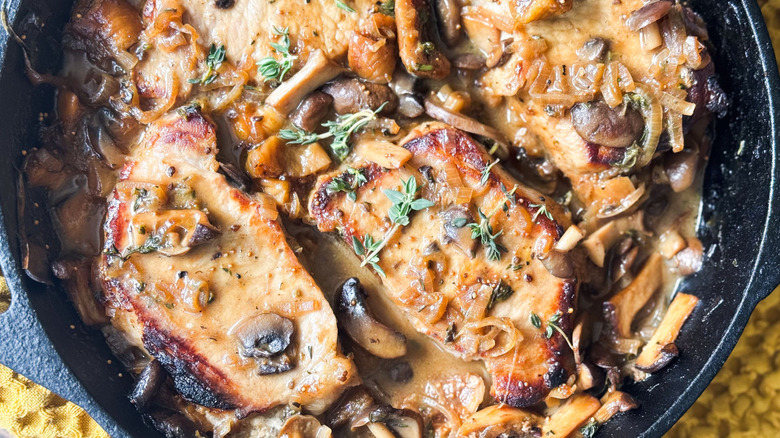
Ingredients
- 1 cup raw apple cider vinegar
- 1 cup water
- ¾ cup fresh orange juice, divided
- ¼ cup dark brown sugar
- 1 tablespoon + 1 teaspoon kosher salt, divided
- 1 tablespoon aniseed
- 4 (6-ounce) boneless pork loin chops
- 1 cup dried soft Turkish figs
- 4 tablespoons unsalted butter, divided
- 4 cups mixed sliced fresh mushrooms (oyster, cremini, brown beech, portobello)
- 1 cup thinly sliced shallots
- 1 cup chicken broth
- 2 tablespoons red wine vinegar
- 2 tablespoons fresh thyme leaves
- 1 tablespoon Dijon mustard
- ½ teaspoon freshly ground black pepper
Directions
- For the brine, whisk together the apple cider vinegar, water, ½ cup orange juice, brown sugar, 1 tablespoon kosher salt, and aniseed.
- Transfer the brine to a large zip-top bag and add the pork, pressing the air out of the bag to seal.
- Refrigerate the pork for at least 4 hours and up to overnight.
- While the pork is in the brine, soak the figs in enough hot water to cover them for about 20 minutes.
- Drain the figs and cut into quarters. Set aside.
- Remove the pork from the brine and blot dry with paper towels. Discard the brine.
- In a cast iron or other heavy, large skillet, heat 1 tablespoon butter over medium-high heat.
- Add the pork and brown for about 4 minutes per side.
- Transfer the pork to a plate and tent with foil to keep warm.
- Heat 2 tablespoons butter in the pan.
- Add the mushrooms and remaining 1 teaspoon salt. Cook until the mushrooms release their liquid and start to brown, stirring occasionally (about 5 minutes).
- Add the shallots and saute until tender and golden (about 5 minutes).
- Pour in the chicken broth, red wine vinegar, and remaining ¼ cup orange juice, stirring to scrape up any browned bits in the pan.
- Stir in the thyme, mustard, black pepper, and figs and bring to a boil.
- Reduce the heat to a low simmer and cook until the liquid is slightly reduced (about 5 minutes).
- Stir in the remaining 1 tablespoon butter.
- Return the pork chops to the pan and heat through.
- Serve the pork topped with the aromatic sauce.
Nutrition
| Calories per Serving | 522 |
| Total Fat | 25.7 g |
| Saturated Fat | 11.8 g |
| Trans Fat | 0.1 g |
| Cholesterol | 125.7 mg |
| Total Carbohydrates | 35.2 g |
| Dietary Fiber | 3.8 g |
| Total Sugars | 24.5 g |
| Sodium | 1,348.8 mg |
| Protein | 38.4 g |
What are the best mushroom varieties to use in this recipe?
With so many mushroom varieties available, it's tricky to know which work best in recipes. This recipe uses a trio of mushrooms with delicate, earthy flavors and robust textures that hold up well while braising. Cremini mushrooms are cousins of common white button mushrooms but they're harvested later in the growing process, giving them a meatier and more savory flavor and texture.
Another meaty mushroom is the king oyster, or king trumpet. These mushrooms pack a ton of flavor into every bite and have a meat-like texture. The stems on king oysters are firm and dense but should never be discarded — they're the tastiest part. Lastly, brown beech mushrooms are a unique addition to the sauce. They are often used in Asian cuisine but have a mild and nutty flavor that makes them versatile. Although they come clustered together in a bunch, they are easy to separate into small, separate mushrooms that cook quickly but keep their texture.
Portobello mushrooms would also complement this recipe nicely, but Kinnaird suggests staying away from shiitakes. The flavor is much stronger and does not work as seamlessly with the figs and thyme. One other option would be to reconstitute a few dried porcini or morel mushrooms, chop them finely, and add them to the sauce along with the figs. This would add a more intense mushroom flavor to the dish and some extra woodsy elements.
What can I substitute for the dried figs?
If you don't have dried figs or if you find some fresh beauties at the market during fig season, go for the fresh! Fresh figs will break down more easily in this sauce. They won't have the same concentration of sweetness that the dried figs have, but they add their own unique flavor. Look for figs that are slightly soft but not overly ripe or mushy. There are hundreds of varieties of figs out there, but a few popular types tend to be more prevalent. Calimyrna and Adriatic figs have green skins, while Turkish figs have dark brown skins with bits of green and purple. If you opt for fresh figs, use 1 cup or more of quarters or halves (depending on the size of the figs) and add them at the same step indicated for the dried.
Kinnaird also suggests trying dried apples or prunes in this recipe. Both of these complement the savory flavors of the mushrooms and shallots while still pairing well with the herbaceous flavor from the fresh thyme. Prunes tend to be quite soft and would not require any kind of soaking before using. Their sweetness would give a nice depth to the sauce and add a similar flavor as the figs. If your apples need some softening, add them along with the shallots to start breaking down the fibers before the liquids are introduced.

